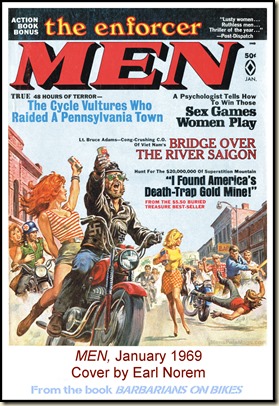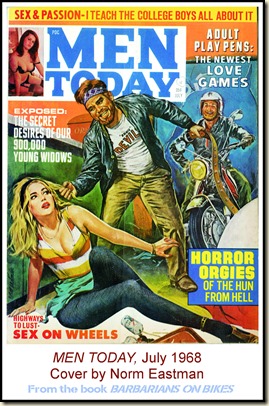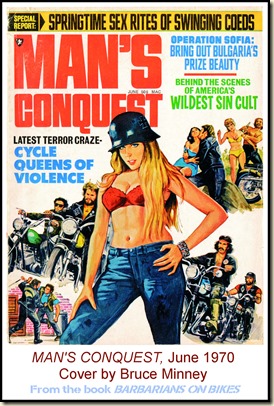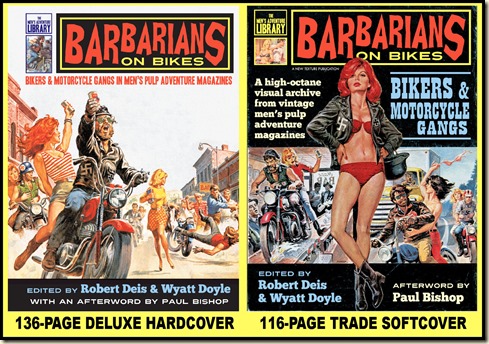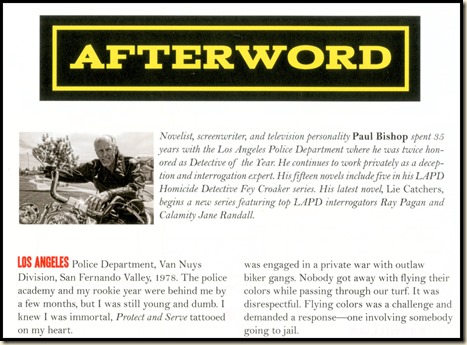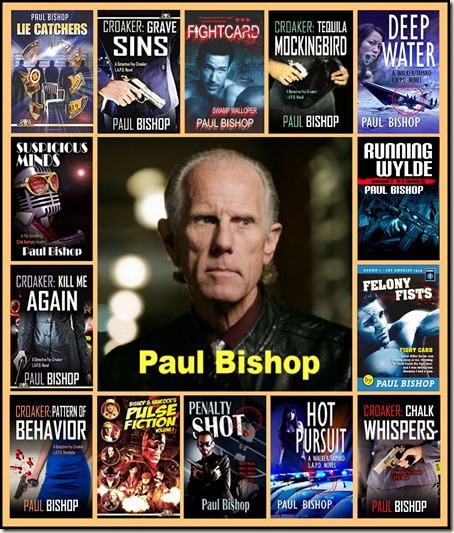
EDITOR’S NOTE: Paul Bishop seems like he should be a fictional character in a novel like those he writes. He served with the Los Angeles Police Department for 35 years. For most of that time, he was a police detective, a top level crime-solver specializing in sex crimes who developed extraordinary skills as an interrogator. Paul retired from law enforcement in 2015, but he still teaches interrogation techniques in seminars for police, military and arson investigators nationwide.
Starting in the late 1980s, Paul also became a prolific writer and media personality. He’s written numerous TV and film scripts and appeared as an expert on various shows. To date, he has written fifteen novels, including the highly-praised Fey Croaker series about a female L.A.P.D. detective, which is now being reprinted by Pro Se. His latest novel, LIE CATCHERS, is the first in a new series about a special team of L.A. police interrogators.
Paul is also a book editor and publisher. He’s the creator and editor of the popular noir-flavored “new pulp” FIGHT CARD boxing novel series. There are now 50 books in that series written by 46 different authors (including Paul), under the house pseudonym Jack Tunney. In addition, Paul writes short stories for collections like BISHOP & HANCOCK’S PULSE FICTION and the incarnation of the classic BLACK MASK magazine.
I don’t know when Paul sleeps, but in his “spare” time, he is also a prolific blogger. He posts regularly on his own blog, PaulBishopBooks.com, and contributes to several others, like the recently-created Bibliorati site. Many of his posts are about action and adventure-oriented novels, magazines, and TV shows and movies. He also writes about the art and business of writing and indie publishing. He frequently posts interviews with writers and publishers – including several he’s done with me and publishing partner Wyatt Doyle about books in our Men’s Adventure Library series, most recently our collection of artwork and photos from men’s adventure magazine stories about outlaw motorcycle gangs, BARBARIANS ON BIKES.
After Paul did that last interview with us, it made me realize it was time to turn the tables and do an interview with him for my blog. It seems especially appropriate given that Paul wrote a special Afterword for BARBARIANS ON BIKES, based on some experiences he had with “one percenter” bikers when he was with the LAPD.
Here’s my interview with the amazing Paul Bishop…
BOB DEIS: When you look at the outlaw biker stories featured in BARBARIANS ON BIKES based on your experience, what percentage of them seem to have some basis in reality?
PAUL BISHOP: Most good fiction has some basis in reality. However, the stories about outlaw bikers in the men’s adventure magazines expanded on the most salacious and prurient aspects of the biker lifestyle to cash in on the shock value. The stories were designed to prey on the fears of what outlaw bikers might do to your wife, girlfriend, or daughter sexually—and the fear your wife, girlfriend, or daughter might like it. Feminism wasn’t a big part of the men’s adventure magazines.
The reality was, the outlaw biker gangs were bad dudes, who did bad things (mostly to each other), committed bad crimes like drug dealing and gun running, and every once in a while actually terrorizing innocent towns and citizens. The men’s adventure magazines took these facts and turned them into lurid tales of constant fearmongering, chain fighting, loud full open throttles, and sexual abuses—all for a voracious, voyeuristic, audience who enjoyed living the experiences vicariously.
BOB: As you know, in the 1960s and 1970s, when men’s adventure magazines were regularly featuring stories about motorcycle gangs, there were lots of biker “exploitation” movies similar to those stories and lots of bikers in TV shows. Did people in law enforcement think the fascination with outlaw bikers in those decades was strange?
PAUL: Not at all. We had our own fascination with the outlaw biker gangs. In some ways cops and outlaw bikers were two sides of the same coin—the brotherhood, the uniform, the macho posturing, the superior attitude. As a rookie, my training officer made it clear we never backed down when faced with bikers or gang members because we were the biggest, toughest, gang in town.
Going toe to toe with bikers on the streets in the real world was one thing. Those were open confrontations with clearly drawn sides. However, trying to infiltrate the gangs undercover was a dangerous, near impossible assignment even Jim Phelps wouldn’t accept (forgive the anachronistic ‘60s reference). It was occasionally done successfully, but the deep cover mockingbirds were never the same when they resurfaced to testify against the bikers they had been sent to penetrate. After years of living as outlaw bikers, the mockingbirds never seemed to be able to readapt back to the straight world. Most long term mockingbirds (undercover for two years or more) leave the department within two years of resurfacing—some commit suicide after resigning. It’s a very tough job.
BOB: While you worked with the LAPD, you were also turning into a professional writer. Your first novel was a Western, SHROUD OF VENGEANCE, published under the name Pike Bishop in 1987. Then you focused on crime novels, including your highly-praised Fey Croaker series.
PAUL: Technically, my first novel was SHROUD OF VENGEANCE, a title in the Diamondback series of adult westerns, published under the house pseudonym “Pike Bishop.” It featured plenty of six-gun and sagebrush action built around the two required explicit sex scenes – the raison d’etre for the very existence of the successful adult western genre. I would never disparage the genre or disavow my connection to it.
But I actually consider CITADEL RUN to be my first novel. I created the characters, the plot was uniquely mine, there were no required sex scenes to wedge in, and my real name was right there on the covers of both the hardback and the paperback.
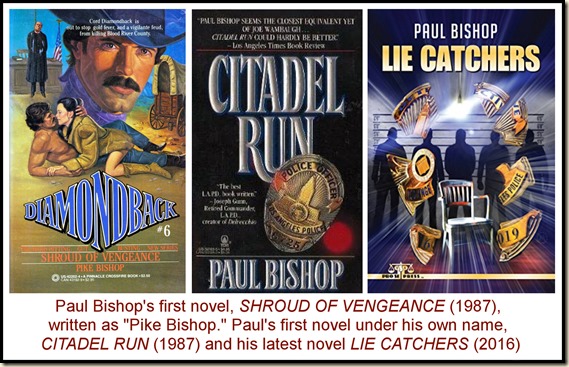 BOB: On your blog, you write a lot about pulp adventure related topics, including vintage action/adventure novels, Westerns, spy novels, early pulp mags, men’s adventure mags, and action/adventure TV shows and movies. How have those genres influenced your work as an author?
BOB: On your blog, you write a lot about pulp adventure related topics, including vintage action/adventure novels, Westerns, spy novels, early pulp mags, men’s adventure mags, and action/adventure TV shows and movies. How have those genres influenced your work as an author?
PAUL: Before I was a cop, before I was a writer, I was a reader. As a reader I was drawn to the world of adventure, pulp, and noir. The art from the pulps and the men’s adventure magazines fed my already wild imagination. I cut my teeth on what was called the “High Adventure” genre back in the day—writers like Desmond Bagley, Alistair MacLean, and Hammond Innes.
The men who actually created the High Adventure genre, Talbot Mundy and Harold Lamb did so in the pulps of the ‘30s and ‘40s. If you want a stunning example read Mundy’s SOUL OF A REGIMENT—it still gives me chills whenever I revisit it.
Today, the High Adventure genre has been watered down to become bloated, doorstop-sized, generic tomes referred to as “Thrillers.” I’ve tried, but I can’t get passed my 50 page rule with most of them. I’m happy collecting and reading the lean, muscular prose of those early novelists, filled with twisted characters, dark deeds, and heroes who weren’t angst filled alcoholics with relationship issues—Gak!
Fast-paced, two-fisted tales were the life blood of the pulps and the men’s adventure magazines. The wordslingers in those pages knew their stuff, and they were the template I copied when I started to write. Along the way, I’ve learned how to adapt to the modern market—writing in many fields from magazine articles to short stories to novels to episodic television and feature films, but I’ve never forgotten the power of the lessons I learned from all the authors I love to read.
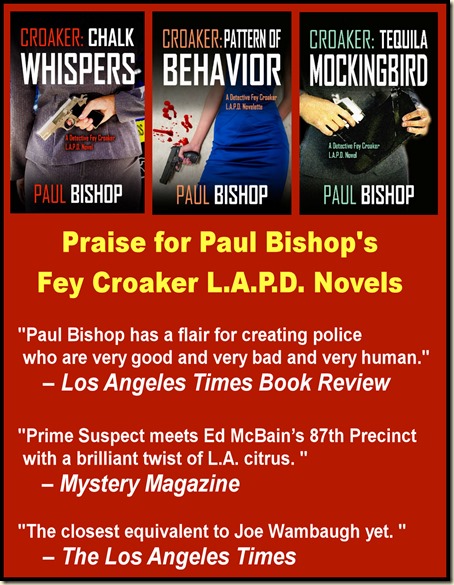 BOB: I think the Fight Card series of novels you created, edited, and published is one of the best examples of what is now commonly called “new pulp.” What did you learn as a writer and publisher from doing that series?
BOB: I think the Fight Card series of novels you created, edited, and published is one of the best examples of what is now commonly called “new pulp.” What did you learn as a writer and publisher from doing that series?
PAUL: By the time I edited the fifty novels in the Fight Card series submitted by forty-five different writers, I saw the same mistakes and strengths over and over. This help me to not only recognize the glaring issues in my own writing, but—more importantly—what to do about them. I learned to be a stronger writer.
However, the Fight Card experience went far beyond writing lessons. I had a blast working with a bunch of writers all on the cusp of their breakthrough into the big time. Some have had their breakthrough already while some are still peaking, but every one of the Fight Card team were certifiable inkspillers of the top order. Their friendships and interaction have help keep my faith in humanity.
BOB: You’ve also written some short stories for new pulp anthologies. One of the recent examples is your story “A Bucketful of Bullets” in the reincarnated version of the classic pulp magazine BLACK MASK published by Altus Press. Are you planning to do more pulp-style short stories or novels?
PAUL: I’ve got a teetering stack of ideas for more short stories, but the issue is finding the time to write them. Writing is often about dollars and cents, and short-stories don’t pay for dinner, let alone pay the gas bill. As a result, I only write short stories when the idea won’t leave me alone or there is an opportunity—like the cover story for the first issue of the revived BLACK MASK magazine—I can’t resist.
BOB: I know you’re familiar with both the early pre-World War II pulp magazines and the post-WWII men’s pulp adventure magazines. What are some of the connections you see between those two genres?
PAUL: I believe their heart beats with the same blood. The men’s adventure magazines were simply the pulps reinventing themselves for a new generation. Then the pulps and the men’s adventure magazines both reinvented themselves again as the men’s adventure series paperbacks—The Executioner, The Destroyer, The Penetrator, and their virtually uncountable clones. Today, with the advent of e-books, those types of lean, mean, muscular stories have had another rebirth showing there is still a hungry market for the wonderful mix of violence, sex, and more violence.
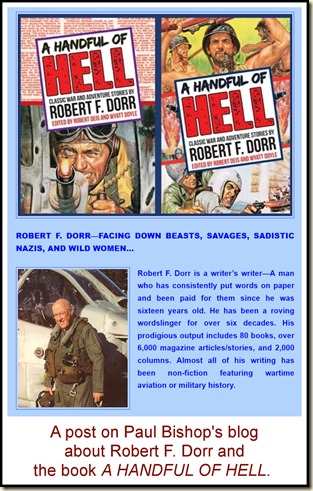 None of this means these stories are disposable or of no value. They do what good writing is supposed to do—entertain. Coupled with the cover art, they speak directly to the American experience, frustrations, and vicarious desire for action.
None of this means these stories are disposable or of no value. They do what good writing is supposed to do—entertain. Coupled with the cover art, they speak directly to the American experience, frustrations, and vicarious desire for action.
BOB: I’m honored by the fact you’ve read the books in our Men’s Adventure Library series and interviewed us about them for your blog. Of the many writers and artists we feature in the stories in our books, do you have any special favorites?
PAUL: As you know, through the Men’s Adventure Library anthology A HANDFUL OF HELL, I became friends with Robert F. Dorr during the last eighteen months of his life and did an interview with him for my blog. I was moved and impressed by Bob’s courage, spirit, and attitude toward his work and life. He epitomized the characters he wrote about—brave, bold, and outspoken. He was a writer’s writer—writing every day to the end. He was a man I was grateful to know and call my friend.
When it comes to illustrators, Mort Künstler always takes my breath away, while Norm Eastman is a very close second. And, of course, my favorite models are Eva Lynd and Steve Holland.
BOB: Recently, you helped establish a great new Facebook group about “Men’s Adventure Paperbacks of the 70s & 80s.” Tell me more about how the group was started and the types of books it focuses on.
PAUL: Starting in the late ‘60s, paperback originals began to dominate the spinner racks in drug stores and markets. Some paperbacks continued to be reprints of hardcover fiction, but low brow publishers such as Monarch, Manor, Tower, Belmont and Pinnacle churned out paperback originals which were direct descendants of the pulp magazine ethos—lurid covers splashed with garish colors and killer tag lines designed to trigger impulse buying. Between the covers were stories filled with harsh, raw, writing featuring lots of violence and sex—the two great American guarantees of sales.
Fawcett’s Gold Medal imprint became the standard by which all paperback originals were judged. They were the proving ground for a generation of now venerated writers. However, when Pinnacle published Don Pendleton’s WAR AGAINST THE MAFIA—the first in the The Executioner/Mack Bolan series—the whole game changed and men’s adventure series became virtually an overnight sensation.
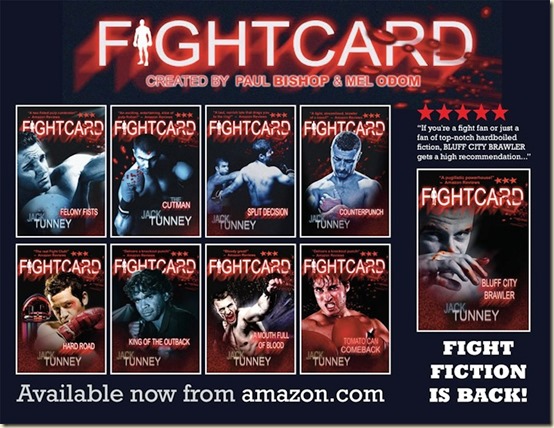 The success of The Executioner caused the world of the paperback original to explode with similar series…The Destroyer, The Penetrator, The Expeditor, The Death Merchant, The Butcher, The Lone Wolf, The Handyman, The Sharpshooter, The Marksman, ad infinitum…These were almost all monthly series featuring vigilantes usually taking on the mob, but any bad guy organization with a lot of disposable goons would do.
The success of The Executioner caused the world of the paperback original to explode with similar series…The Destroyer, The Penetrator, The Expeditor, The Death Merchant, The Butcher, The Lone Wolf, The Handyman, The Sharpshooter, The Marksman, ad infinitum…These were almost all monthly series featuring vigilantes usually taking on the mob, but any bad guy organization with a lot of disposable goons would do.
These books paved the way for other men’s adventure series featuring soldier of fortune, mercenaries, and over the top secret agents who would all accept missions too dirty and too difficult for any governmental organization forced to play by the rules—deniability was key. Death and destruction…and sex…followed.
BOB: I’ve noticed you’ve been featuring a lot of Westerns in that group lately, too.
PAUL: Yes. Similar series were spawned in the western genre. The Edge series by George G. Gilman (pseudonym for Terry Harkness) led the charge to take the traditional western oater into a new recidivist version soaked in blood, visceral carnage, and bullets.
Edge was the first series written by a loose knit group of British writers who would become known as the Piccadilly Cowboys—since they had never been west of Piccadilly in London’s West End, yet wrote an abundant of ultra-violent western series: Bodie The Stalker, Hart The Regulator, Breed, Apache, Jubal Cade, and a ton of others. American western writers quickly followed: The Gunsmith, Slocum, Longarm, Lone Star, Trailsman, ad infinitum again…
Those of us whose teen years were irrevocably warped and scarred by overdosing on these series, retain an unreasonable fondness and attachment to these books. Finding out about the authors who hid behind the many pseudonyms is ridiculously important to us. Collecting full runs of these books in their various editions and in decent condition is an obsession.
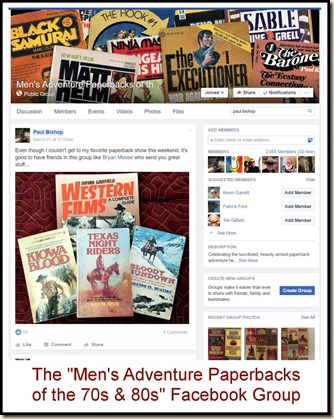 The Men’s Adventure Paperback Series of the 70s and 80s group on Facebook has become the in place for all us niche misfits to gather (2,000 members and growing) and genially discuss the various aspects of what the world mostly considers trash fiction. I have to say it has been a wonderful group to hang out with in the virtual world. The knowledge base is amazing and freely shared. Books are often traded, or even sent free to other members.
The Men’s Adventure Paperback Series of the 70s and 80s group on Facebook has become the in place for all us niche misfits to gather (2,000 members and growing) and genially discuss the various aspects of what the world mostly considers trash fiction. I have to say it has been a wonderful group to hang out with in the virtual world. The knowledge base is amazing and freely shared. Books are often traded, or even sent free to other members.
BOB: How does that work?
PAUL: A member will sometimes start a box of twenty action novels, westerns, or another specific genre rotating through ten to fifteen other members who have signed up. When a member receives a box, he takes out the books he wants, replaces them with other good stuff and sends it on. The box eventually makes its way back to the originator—usually with many more books than it started with—and a new round is begun. All of this has been stress free, informative, and congenial fun—the complete opposite of many of the horribly rancorous groups spawned by social networks.
BOB: Seeing posts by you and other members of that group made me more aware of the many connections between the vintage men’s adventure novels and men’s adventure magazines. Have you become more aware of those connections yourself as you’ve done your posts?
PAUL: Absolutely. The line between the two is tissue thin. Fans of either category—magazines or paperbacks—can find much to like in both genres. Most fans of one should be fans of the other. However, while both genre fans love the cover art and the stories, I theorize those who are men’s adventure magazine fans are slightly on the side of the cover art, and fans of the men’s adventure paperbacks are more on the side of the stories.
 BOB: Who are some of your favorite writers and covers artists in the realms of men’s adventure paperbacks?
BOB: Who are some of your favorite writers and covers artists in the realms of men’s adventure paperbacks?
PAUL: Don Pendleton and Warren Murphy are the King and Czar of the men’s adventure paperback genre. John Benteen, author of both the Fargo and Sundance series, is my answer to anything having to do with paperback westerns. However, there are a lot of other writers who also get my attention, such as Peter McCurtain, Donald Hamilton (Matt Helm rules), Edward S. Aarons, Alan Caillou and Marvin Albert.
Then there are the contemporary guys, many of whom are friends—Steve Mertz, James Reasoner, Bill Crider, the late Ed Gorman, Len Levinson, Robert Randisi, and a bunch of guys who are gonna be pissed because I left them off this short list.
Other western writers I dig include, Frank O’Rourke, Frank Gruber, Louis L’Amour, Brian Garfield, Luke Short, Frank Bonham and Jack Bickham. I also have to mention two of my favorite western series—Buchanan and Lassiter—written by many different typewriter slaves under a shared pseudonym.
Robert McGinnis is by far my favorite paperback illustrator—I’ll collect anything if it has a McGinnis cover. If I had the sway to get him to do a cover for one of my books, I would die a happy man. Gil Cohen and Frank McCarthy are also on my list, but I’m also drawn to much of the uncredited art on western paperbacks from the ‘70s.
BOB: You often write about the art of writing on your personal blog and recently you became a founding contributor for the new website BIBLIORATI, which is subtitled “For Readers and Those Who Write for Them.” Tell me about that site and who’s involved.
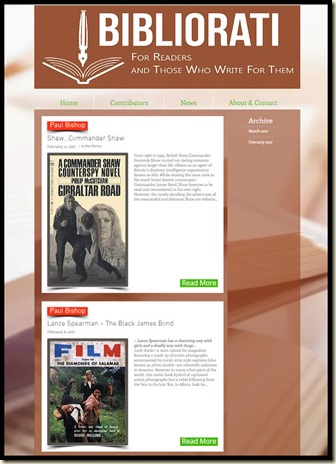 PAUL: My good friend Tommy Hancock got a wild notion, as he often does, that he could produce a daily magazine style blog with regular columnists, honest book reviews, and industry insight along with publishing and genre news—and do it better than other similar webzines. A bunch of hard work later and I believe he’s accomplished what he set out to do.
PAUL: My good friend Tommy Hancock got a wild notion, as he often does, that he could produce a daily magazine style blog with regular columnists, honest book reviews, and industry insight along with publishing and genre news—and do it better than other similar webzines. A bunch of hard work later and I believe he’s accomplished what he set out to do.
Bibliorati has room to grow and will extend its reach every day and every week. I enjoy being part of that growth, having a place to channel my musings about the eclectic things I find interesting—hopefully, others will as well.
BOB: Your most recent novel, LIE CATCHERS, which I loved, is a different kind of police detective novel. It involves some characters with special abilities, a sort of enhanced form of empathy that helps them tell whether people are lying and solve crimes. Is there a real basis for that?
PAUL: The short answer is everything the interrogators do in LIE CATCHERS, I’ve done—for better or worse. I am a nationally recognized interrogator and teach interrogation to law enforcement officers and detectives nationwide. When I realized most of the experienced detectives were unaware of proper and successful techniques, I realized my readers wouldn’t know about them either. It gave me my own niche within the police procedural genre. With LIE CATCHERS, I set out to write a book as close as possible to how interrogation really works within a fictional setting—which is unlike anything you’ve read before or seen on TV.
BOB: LIE CATCHERS has had a very warm reception. It has more than eighty 5-star reviews on Amazon, which is extraordinary. Are you planning a sequel?
PAUL: Yes. The sequel ADMIT NOTHING will be published in the latter part of 2017. Two further sequels, DENY EVERYTHING and DEMAND PROOF are planned.
BOB: I look forward to reading those. I loved LIE CATCHERS, as my own 5-star review of it on Amazon says. What else can we look forward to from Paul Bishop in 2017?
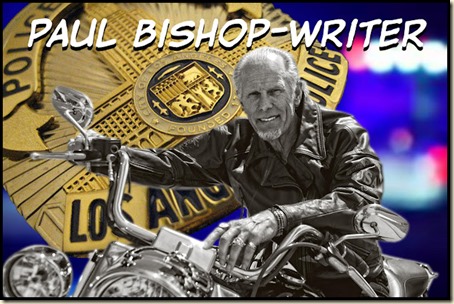 PAUL: I have a special project I’m very excited about that will be announced as soon as the ink is dry on the contract. I’m also working with my friend, Scott Harris, on a series of entertaining semi-reference books, 52 WEEKS 52 WESTERNS, 52 WEEKS 52 WESTERN MOVIES and 52 WEEKS 52 WESTERN TV SHOWS. We’re having a blast putting these together and writing all the entries (with the help of a bunch of guest contributors) and look forward to them being published in late 2017 and early 2018.
PAUL: I have a special project I’m very excited about that will be announced as soon as the ink is dry on the contract. I’m also working with my friend, Scott Harris, on a series of entertaining semi-reference books, 52 WEEKS 52 WESTERNS, 52 WEEKS 52 WESTERN MOVIES and 52 WEEKS 52 WESTERN TV SHOWS. We’re having a blast putting these together and writing all the entries (with the help of a bunch of guest contributors) and look forward to them being published in late 2017 and early 2018.
As usual, I’ll also be doing various speaking engagements and seminars, some for law enforcement officials and some for writers, like the 2017 Writers’ Police Academy. [Scheduled for August 10-17 in Green Bay, Wisconsin.]
BOB: Thanks, Paul. And thanks again for writing a great Afterword for our book BARBARIANS ON BIKES. You tell a gripping story in it about an encounter you once had with a Hells Angel biker. In closing, could you tell me another anecdote about your experiences with outlaw motorcycle club members during your time with the Los Angeles Police Department?
PAUL: There was one instance when I arrested an outlaw biker after he’d been involved in a fight at a local bucket of blood bar—a term applied generically to any hangout frequented by tough guys. He was relatively cooperative, so I allowed him to supervise how the tow truck driver hooked up his hog for transport to the impound lot. However, by the time we were in the booking cage, his attitude had changed and he became a belligerent, combative, butt-hair.
There was a scuffle and the fight was on. Once the jailers and my partner jumped in, the fray didn’t last long, but I ended up with a tear in a brand new pair of uniform pants. I had my revenge by taking the suspect’s colors to the dry cleaners to be washed and starched to the point of rigidity. When the biker bailed out, I presented his beautifully clean and sweet smelling Levi vest back to him on a hanger in a dry cleaners plastic bag. He almost cried. The last I saw of him, he was throwing his colors into the street outside the station again and again, letting them get run over by cars and busses in an effort to make them wearable again.
Comments? Corrections? Post them on the Weasels Ripped My Book Facebook Page
or join the Men’s Adventure Magazines Facebook Group and post them there.
Recommended reading…


